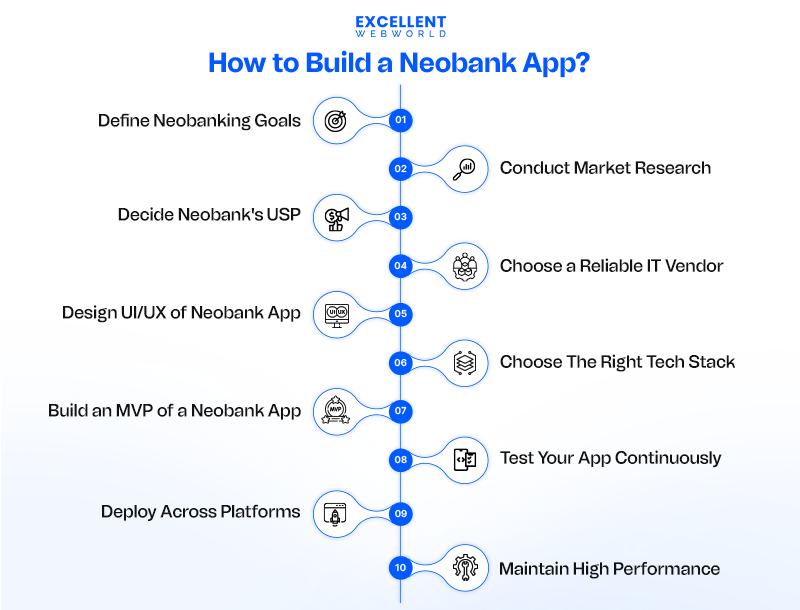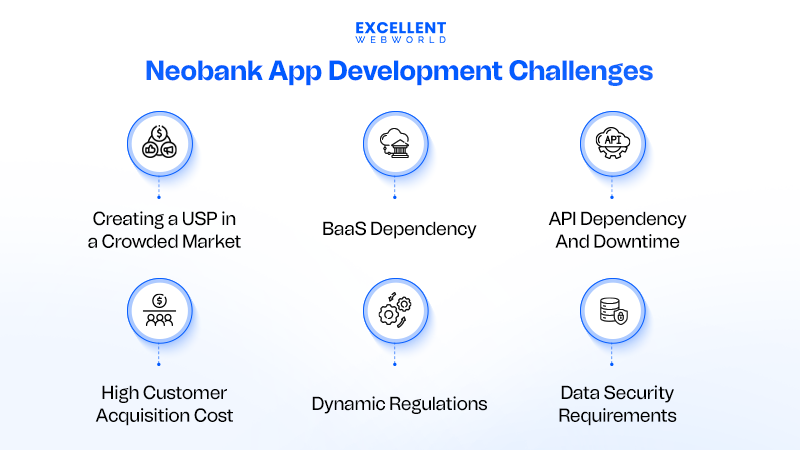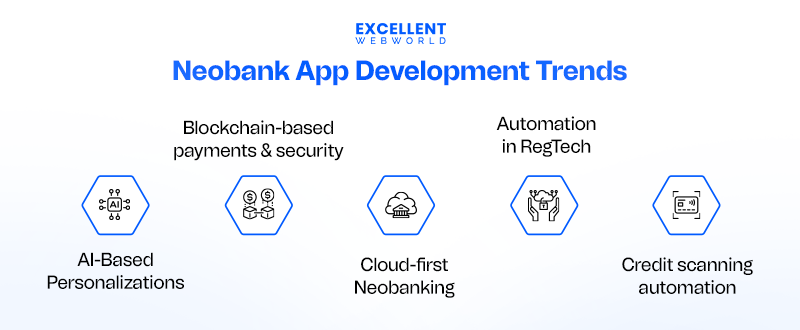Neobank app development is transforming the financial industry by removing the need for physical branches and delivering fully digital banking experiences. A neobank is a digital-only bank that operates entirely online, offering services such as payments, savings, loans, and more without any physical infrastructure.
Unlike traditional banks that create fintech apps as extensions of their existing services, neobank app development involves building a complete virtual banking system from scratch. This innovative approach has driven the global neobanking market to a projected value of over USD 210 billion by 2025.
As the demand for digital-first financial solutions continues to rise, financial institutions, government-backed startups, and fintech companies are increasingly investing in neobank app development. However, creating a neobank app is more complex than launching a standard banking app. It requires a strategic roadmap, strong technical foundations, compliance with financial regulations, and a clear understanding of user expectations.
In this guide, you will find everything you need to know about neobank app development in 2026, including the development process, key features, challenges, future trends, and a detailed breakdown of the associated costs.
What is a Neobank?
A neobank is a digital-first financial institution that does not require a physical branch, unlike traditional banks. It delivers banking services online through a mobile application. Neobank app development enables you to offer personalized banking experiences through mobile apps, enhancing both convenience and accessibility.
If you are developing a neobank from scratch, licensing becomes essential. Neobanks are licensed financial businesses that operate entirely online. These banks offer a more personalized experience as each financial product is designed based on user preference. However, neobanks can partner with traditional banks to provide digital financial services.
Now that you know what a neobank is, here are some key reasons why you should consider it a feasible business.
Why Build A Neobank?
There has been a seismic shift in the banking industry in recent years. This shift towards digitization has led many conventional banks to create mobile banking apps. However, consumer demands have been changing, leading to the rise of a complete virtual banking experience.
This has led to more than 400 neobank launches in a very short time. At the same time, increased competition has also created a barrier to market entry. Many funded startups and small businesses aim to launch their neobanks and overcome this barrier.
But why is it so important?
You are likely aware of the advantages of neobanks, including lower operational costs and improved revenue generation opportunities. However, developing a neobank from scratch requires a strategic approach.
How to Build a Neobank App? [10 Simple Steps]
Building a successful neobank requires expertise in technical aspects and an understanding of the financial market. Therefore, if you aim to develop a scalable neobank app for your FinTech business, finding a custom software development service becomes crucial. It can help streamline the entire process of building a neobank app, whether it’s for digital banking or specialized solutions like wealth management software development.
This process to build a neobank app has several steps, like,
Step 1 – Define Neobanking Goals
Establish clear objectives for your neobank, including the target audience and business model. For example, is your bank serving a niche market, offering specialized financial services, or competing with traditional banks? Your goals must align with key FinTech trends while maintaining a unique value proposition.
Pro Tip: Develop a comprehensive business plan with specific key performance indicators (KPIs) to accurately measure your neobank’s success. This will ensure the end-to-end app development process is streamlined and delivers measurable results.
Step 2 – Conduct Market Research
Market analysis helps you make strategic decisions, such as the key neobank app features, resources, and stakeholders. Conduct a thorough analysis of the existing neobanks, traditional financial institutions, and emerging banking trends.
Identify market gaps and understand customer pain points. You can fill these market gaps through customized software development solutions. For example, you can conduct surveys targeted at millennials. This will help you understand how users from specific demographics use online banking services.
Market research is also crucial in determining the business and revenue models to follow for a successful neobank app in a competitive market. Some of the key monetization models that you can leverage are,
Pro Tip: Organize focus groups and surveys with potential customers to gather key insights on whether they prefer neobanks over traditional banks or prefer budgeting apps. It will help strengthen your app development solutions strategy.
Step 3 – Decide Neobank’s USP
Your neo bank’s unique selling proposition (USP) will be its differentiator in a crowded marketplace. Especially if you consider the market size of neobanks, which is expected to rise to USD 10.44 trillion by 2032. This is why defining the USP becomes a necessity for your Fintech business. It can be superior interest rates, specialized services for underserved demographics, or innovative features.
Pro Tip: Partner with an expert firm that offers full-cycle web and mobile application development. It can help translate your USP into tangible software solutions.
Step 4 – Choose a Reliable IT Vendor
You will need expertise to handle the regulatory requirements and technical complexities of developing a neobank from scratch. This is why choosing the right technology partner is essential. Find an expert company that offers end-to-end software development and has proven experience in regulatory compliance.
Pro Tip: Evaluate potential partners based on their portfolio, technical expertise, and understanding of banking regulations.
Step 5 – Design UI/UX of Neobank App
Your customers will experience the app’s financial services, which means your UI needs to be on point and designed with a user-centric approach. Use an experienced app design service and create a detailed tutorial that guides the customer in navigating your application easily.
Some tips that you can follow are,
Pro Tip: Implement AI-powered digital product design to create personalized, data-driven user experiences.
Step 6 – Choose The Right Tech Stack
Selecting the right technology stack can be a key differentiating factor for your neobank app. Therefore, select a tech stack that aligns with regulatory compliance, time-to-market goals, licensing costs, and scalability requirements.
Tech stack options for a neobank app development project:
| Tech Stack Category | Technologies |
|---|---|
| Frontend | Swift (iOS), Kotlin (Android), Flutter, and React Native |
| Backend | Node.js, Java, Python, Django, and Flask |
| Database | PostgreSQL, MySQL, and MongoDB |
| Cloud | AWS, Google Cloud Platform, and Azure |
| CI/CD | Jenkins, GitHub Actions, and GitLab CI |
| API Design | RESTful or GraphQL |
Pro Tip: Consult with experts who offer cutting-edge digital solutions and services to build a tech stack that can cope with the complexities of a neobank app development project.
Step 7 – Build an MVP of a Neobank App
Once the design and tech stack are ready, the next step is to build your digital bank app. However, creating a minimum viable product (MVP) before developing a full-fledged app is essential. This approach allows you to enter the market quickly, gather user feedback, and iterate continuously.
Using MVP, you can,
Pro Tip: Focus ruthlessly on solving one core problem rather than addressing multiple pain points during the MVP stage. This will enable you to identify and resolve errors and issues with your app early on.
Step 8 – Test Your App Continuously
Implement rigorous testing throughout the development lifecycle. Banking applications require a secure backend to maintain customer trust and regulatory compliance. So, you must test the neobank app for data security and any possible vulnerabilities. A crucial aspect of neobank app testing you must cover is scalability. Make sure you test the app for its ability to handle financial transactions at scale.
Pro Tip: Implement automated testing frameworks to ensure consistent quality across all features.
Step 9 – Deploy Across Platforms
When deploying the neobank app, you must ensure it complies with all platform standards. For example, if you are deploying the app on the iOS platform, you need to follow specific security and UI standards. Before deploying your app, ensure that it complies with all platform-specific regulations and guidelines.
Pro Tip: Leverage multi-platform deployment to maximize the reach of your app across the audience.
Step 10 – Maintain High Performance
Your app has been launched, but it’s not over! You need to continuously maintain the performance of the neobank application. With the right tech partner, you can ensure continuous performance. They offer post-launch support and maintenance, ensuring higher performance.
Pro Tip: Invest in a custom-built software solution with robust analytics capabilities to track performance metrics and identify opportunities for optimization.
Using these steps, you can create a neobank app from scratch. However, feature identification and development are among the most critical aspects of these steps. To build a successful mobile banking app, you must create features that align with consumer demands.
Neobank App Features For Personalized Finance Management
Personalizing banking for your customers’ needs involves functional and advanced features. For example, one of the standard modes of payment these days is through QR codes. Adding QR-based payments to your neobank app makes sense. Apart from the QR-based payments, here are some of the other key features,
| Feature | Description |
|---|---|
| Transaction Authorization | Ensures secure processing of transactions through methods such as two-factor authentication (2FA) |
| Biometrics Authentication | Verifies user identities as mandated by regulations to prevent fraud and ensure compliance |
| Push Notifications | Provides real-time updates on transactions, promotions, and offers |
| Cashback and Reward Programs | Allows users to get cashback on transactions and rewards, which they can redeem against specific items |
| Referral Systems | Enables users to expand the bank’s reach while benefiting from rewards |
| Spending Analytics | Offers deeper insights into monthly spending |
| Budgeting Dashboards | Allows users to understand spending trends, balance in accounts, and budgeting data |
| Multi-Currency Accounts | Offers capabilities for users to create multiple accounts and transact across currencies |
| Loan Refinancing and Mortgages | Simplifies complex processes of dealing with loans and managing debts |
| Virtual Cards | Issue temporary digital cards for online and in-app purchases, enhancing security and privacy |
| Stock Trading | Allows users to trade stocks right from the application |
| Cryptocurrency Support | Enables transactions in cryptocurrency |
| Cross-Border Payments | Allows users to make international money transfers and payments |
| Instant Loans And Credit | Provides instant loans to users and makes credit access easier |
| Autopay/Recurring Payments | It enables users to set standing instructions on their neobank app for recurring payments on utility bills, software subscriptions, and more. |
Developing these features requires more than just coding expertise. It requires thorough planning of the entire neo bank app development lifecycle. Each phase can have complexities, and overcoming them will require resources, strategic planning, and execution of those plans. As a FinTech business owner or a funded startup founder, planning and executing everything can become overwhelming.
The overarching influence of cost is in addition to the entire planning and execution phase. Without proper estimation planning, executing the project can be detrimental to your business.
How Much Does Neobank App Development Cost in 2026?
Neobank app development costs in 2026 can range from $40,000 to $275,000, depending on various factors such as app complexity, feature set, and the location of your development team. A neobank app typically falls between $57,000 and $150,000, while a fully custom-built solution can cost anywhere from $100,000 to $275,000 or more.
Understanding what influences these costs is essential for effective planning. In the sections below, we’ll break down the key factors that impact neobank app development costs, so you can make informed decisions based on your budget and business goals.
Breaking Down The Neobank App Development Cost
Neobank app development costs have many parts that you need to analyze before estimating a budget for the project. For example, the cost of designing your Neobank app will differ from development expenses. At each stage, the price will vary depending on multiple factors.
| App Lifecycle Stage | Timeline | Cost |
|---|---|---|
| Project Requirement Analysis | 1 week | $1,000 – $3,000 |
| Planning Stage | 2 weeks | $2,000 – $4,000 |
| Ui/UX Design | 7-9 weeks | $5,000 – $15,000 |
| MVP Development | 3-4 weeks | $20,000 – $50,000 |
| Full-fledged Development | Upto 24 weeks | $50,000 – $150,000 |
| Testing Stage | 2-4 weeks | $5,000 – $10,000 |
| Deployment Stage | 1 week | $1,000 – $3,000 |
It is essential to note that project requirement analysis is free. However, some IT vendors charge analysis and planning fees. The best practice is to find a FinTech app development company that offers free project requirement analysis. Apart from these stages, various factors influence the costs of neobank app development.
Factors Influencing the Neobank App Development Cost
From app complexity to design costs, various factors can impact the total expenses of developing a new bank app from scratch. Understanding each of them will help you plan your budget optimally.
1. Neobank App Development Cost by Complexity
When planning a Neo Bank app development project. These features require more time for development and increase the cost.
For example, developing a cross-border payment feature can lead to multiple complexities. Integrating compatible payment gateways across regions and ensuring secure transactions requires an advanced backend, which can lead to higher costs while developing a neo bank app from scratch.
| App type | Neobank app development cost estimation |
|---|---|
| Simple App | $20,000 to $75,000 |
| Moderately Complex App | $75,000 to $100,000 |
| Complex App | $100,000 to $250,000 |
2. Designing Cost
Designing costs for a neobank app development project can depend on multiple aspects, like,
You require an experienced designer to maintain consistency in the design. If you add more animations and elements to the UI, the app design costs related may increase further due to the expenses of hiring more resources.
3. Platform You Deploy Neobank App
Whether to deploy on iOS and Android can impact the neobank app development cost. Hiring a Fintech app developer for the iOS platform can cost $30 to $100 per hour. At the same time, a FinTech app developer will charge $20- $75 per hour for the Android platform. There is a clear difference between the hiring costs of developers across both platforms.
However, there is one way to reduce the cost of deploying your Neo Bank app, and that is cross-platform app development. It helps you deploy applications across platforms without the hassle of creating code for each native platform.
4. Location of App Development Company
The FinTech app development company you choose for your project can impact the total cost. For example, hiring a development team in the United States can cost between $100 and $150 per hour. At the same time, a mobile app development company in India will charge between $20 and $50 per hour.
| Region | Hourly Rates |
|---|---|
| US | $100 – $150 |
| UAE | $80 – $120 |
| Canada | $70 – $100 |
| Australia | $90 – $130 |
| India | $20 – $50 |
5. Maintenance Cost
Mobile app maintenance fees can significantly determine the cost of neobank app development. Periodic updates, infrastructure costs, customer service, compliance, and performance optimization are all factors that contribute to maintenance costs. You need to manage all these maintenance factors efficiently to ensure that your products are sustainable and profitable in the long run.
What Are the Key Challenges of Neobank App Development?
Building a neobank from scratch has its own set of challenges. For example, developing a neobank requires compliance with anti-money laundering laws. So, you must build a system that complies with the AML regulations. While there are mobile app development technologies that you can leverage to build robust neobanks that offer regulatory compliance, you need a more holistic approach. Especially considering multiple challenges in the crowded FinTech market.
1. Creating a USP in a Crowded Market
A unique value proposition is your differentiator in a crowded market. The neobank market has many players, like Nubank, Chime, and Varo. These neobanks are making access to credit so seamless that Accenture predicts that by 2030, anyone who wants to access credit can quickly get it.
So, where does your neobank app stand in this market?
The answer to this question requires a USP! Your neobank’s unique value will make it a standout option. It can be an exclusive payment option on your neobank app or access to instant credit without paperwork. Speed can be your USP, not just an extra payment option. TBC’s cloud-only challenger bank – ‘Space Neobank’ is a prime example!
Being one of the two biggest banks in Georgia, TBC needed to cope with the market’s changing needs. Significantly, the velocity of new services and product launches was a concern. The answer was a cloud-only neo bank app development approach. It helped them onboard 40,000 customers in just 8 months on the neobank and now serves more than 200,000 users.
2. BaaS Dependency
Many FinTech business owners and financial startups use Banking as a Service (BaaS), which helps them integrate payment gateways, banking services, and customer data analytics. While this does help FinTech businesses initially cut costs and access key resources, in the long run, it leads to multiple complexities.
For example, using a BaaS service can lead to vendor lock-in. This means a single policy change or increase in cost from the service provider can impact the neobank’s operational costs.
Plus, there are challenges of data transparency and control. A possible solution is creating the neobank app from scratch, where you have complete control.
3. API Dependency And Downtime
Neobank apps depend on APIs for almost all features. From facilitating payments to analytics and processing financial data, these apps use APIs to connect vital functionalities to the system.
While it does help neobanks provide a seamless banking experience to customers, there are challenges due to API dependencies. For example, APIs can be prone to cyberattacks, putting the entire system at risk. A possible solution is to ensure secure API integrations through comprehensive testing.
4. High Customer Acquisition Cost
The neobanking services market faces competition from traditional banks. Many conventional financial institutions are not digitizing their systems and processes, so attracting more customers and asking them to switch from traditional banking modes has become challenging.
Plus, the entire banking system in a neo bank is virtual, which also causes trust issues for many customers. A possible solution is to introduce transparent communication with customers. So, if you want to boost customer acquisition for your neobank, ensure better communication and support systems, and integrate advanced features.
5. Dynamic Regulations
FinTech regulations extend to neo banks, and you must comply with financial laws. This can be challenging, especially with multiple regulations overlapping on different security aspects. However, each regulatory authority has specific needs, which can be more complex. For example, data regulations in GDPR are specific to European Union countries.
A possible solution is to have a strategic regulation officer at your neobank that ensures compliance with the dynamic requirements of standards like PCI DSS, GDPR, HIPAA, and AML.
6. Data Security Requirements
Data security is key to complying with all regulations, like GDPR or HIPAA. You must secure users’ financial data as a virtual banking service provider. The volume of transactions will increase, especially when you scale your Neo Bank app, leading to a massive data security challenge.
This is why integrating data security systems into your neobank app is vital. You can also leverage cloud-based infrastructure to ensure data access control. Cloud-based systems offer identity and access management features that allow you to manage data accessibility.
Future Trends For Neobank App Development
Neobank is continuously evolving with new innovations and features redefining the banking experience. For example, banking institutions can leverage AI app development services to integrate custom models. This neobank app development approach will help them transform the entire banking experience.
1. AI-based Personalizations
AI has transformed the way financial services are personalized. So, if you are looking to add personalized financial services, you will need strategic neobank app development. Especially for customization and smart recommendations, you will require expert AI consulting services.
Plus, the advent of AI in the FinTech industry has already changed customer support. It has made responses quick and personalized to specific customer queries. Besides personalization and customer support, AI in Fintech trends also transforms how banks offer digital banking solutions.
2. Blockchain-Based Payments
Blockchain-based payments help FinTech businesses leverage a decentralized approach to payments. Neobanks can use this technology to help users secure payments without a verifying authority to validate each transaction. However, it is mostly unregulated and needs secure systems.
There have been instances of cyberattacks using smart contracts, which is why when learning how to create a stablecoin, you need to make sure the Blockchain systems you use are secure. For example, this instance involved the famous Hong Kong neo bank Stablecoin, which was attacked using a smart contract.
🚨BREAKING: After Bybit’s historic hack, another blow rocks crypto! 🚨
💫Hong Kong-based stablecoin neobank Infini hit with a $49.5M USDC theft on Feb 23, 2025. Hackers exploited a private key, swapped funds to DAI, then bought 17,696 ETH.
💫Founder vows to cover losses to… pic.twitter.com/JPic9aY3rs— 💎TINA NOVA💎 (@BASETinaAI) February 24, 2025
3. Cloud-first Neobanking
Neobanks are already scaling financial services by leveraging the cloud-first approach. This trend will further see widespread adoption with the integration of AI. Neobank app development will need cloud-based systems to scale AI-based personalization. Plus, a cloud-first approach will also allow neobanks to ensure high availability.
4. Automation in RegTech
RegTech automation is a trend that will enhance compliance strategies for neobanks. So, if you are a neobanking service looking to ensure regulatory compliance, RegTech algorithms will help you with regulatory changes, analyze documents, and modify compliance frameworks autonomously. This means neobanks will be able to reduce compliance costs and optimize operations.
5. Credit scanning automation
Conventional credit scanning approaches include background verifications, financial health analysis, and tracking different reports of users before offering a score. However, this trend has become a reality with the advent of AI credit scanning and scoring automation. This trend will further extend and make credit more accessible.
How Excellent Webworld Can Help You Develop A Neobank App?
Banking has changed forever since the advent of mobile technologies. This was further boosted with the introduction of AI, and now, with advanced capabilities, neo banks are redefining the banking experience. However, newer neo banks face stiff competition from the growing market and widespread adoption.
So, if you are looking to create a neobank from scratch, you need expertise. Excellent Webworld is a Fintech app development company with over 13 years of experience delivering advanced banking solutions. With more than 900 successful projects, we have a proven record of creating scalable neobank apps. Contact us if you are looking to develop a neobank app from scratch.
What makes Excellent Webworld an ideal neobank app development partner?
FAQs
Prominent examples include Revolut, Chime, N26, and Monzo. These financial institutions operate exclusively online without physical branches and offer streamlined services.
Building a neobank requires securing appropriate banking licenses (or partnering with a licensed bank), developing robust financial technology infrastructure, creating user-friendly mobile/web interfaces, implementing stringent security protocols, and establishing regulatory compliance frameworks.
Digital banks are traditional banking institutions that have expanded into online services while maintaining physical branches. Neobanks operate exclusively through digital channels without brick-and-mortar locations and typically focus on specialized services with lower overhead costs, enabling more competitive pricing and innovative features.
Development costs for a neobank typically range from $20,000 to $250,000, depending on feature complexity, security requirements, compliance needs, and geographical scope. This estimate covers core technology development, not operational costs or banking license acquisition, which can add several million dollars to the total investment.
The development timeline for a market-ready neobank platform typically spans 24 weeks. This includes requirements gathering and architecture design, core development, testing, and deployment.

Article By
Mahil Jasani began his career as a developer and progressed to become the COO of Excellent Webworld. He uses his technical experience to tackle any challenge that arises in any department, be it development, management, operations, or finance.






